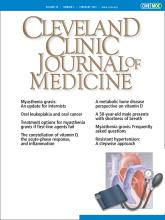In this issue of the Journal, Antonelli and colleagues1 present an important reminder that vitamin D levels are lowered during inflammation, behaving as a negative acute-phase reactant. They acknowledge the high prevalence of low serum levels of 25-hydroxyvitamin D (25[OH]D) and seem to argue that because inflammation is ubiquitous, the widespread findings of reportedly low vitamin D levels are due in large part to inflammation. They assert that lack of appreciation that inflammation is the culprit has led to unnecessary testing and overestimation of the prevalence of hypovitaminosis D, and has contributed to uncertainty about the “cutoff point” for an adequate level of vitamin D.
See related article, page 85
However, there are many factors that influence 25(OH)D levels. It should not be surprising that low levels of vitamin D are common. Sun exposure, which initiates vitamin D synthesis, may be limited by working indoors, geography, seasonal variation of sun intensity, and use of solar protective agents. The ability to make vitamin D precursors is also affected by skin type, age, and genetics. Vitamin D is rare in food, except for fatty fish and fatty fish oils and some foods that are artificially and not always reliably fortified. Obesity, which has increased in the United States, results in a volumetric dilution of 25(OH)D, as this fat-soluble vitamin is distributed into the increased fat, muscle, and liver compartments that are associated with obesity, even though total body stores of vitamin D may be adequate. Many drugs—antiepileptics, glucocorticoids, antiestrogens, antiretrovirals, antineoplastics, and herbs such as kava and St. John’s wort—lower vitamin D levels by upregulating degradative enzymes. All these mechanisms are independent of inflammatory reactions that are the focus of the commentary by Antonelli et al.1
EFFECTS ON BONE
Circulating 25(OH)D is the substrate for physiologically active vitamin D, critical in maintenance of calcium homeostasis and bone integrity. Low vitamin D stimulates an increased parathyroid hormone response, with levels often within the normal range, but it can also cause an elevation above normal.2,3 An increase in parathyroid hormone will maintain the serum calcium level within the normal range, but at the expense of phosphate excretion and removal of calcium from bone, thus adversely affecting bone strength. Initially this is clinically silent, but a chronically reduced active 25(OH)D substrate level from any cause, whether from poor diet, inadequate sun exposure, or low grade inflammation, will still result in reduced vitamin D compounds and a bone-adverse physiologic effect. A 25(OH)D level of approximately 50 nmol/L (approximately 20 ng/mL) is sufficient to maintain calcium and phosphate homeostasis and prevent osteomalacia and rickets but insufficient to lower fracture risk.4,5 Higher serum levels of around 75 nmol (30 ng/mL) are needed for bone health4–6 and are required to reduce risk of nonvertebral and hip fracture.4,5
It is tempting to add vitamin D supplements if the vitamin D level is below 75 nmol/L (30 ng/mL), but that alone may not reduce fracture risk. In a large, well-designed, double-blind, placebo-controlled study, vitamin D3 supplementation of 2,000 IU daily without coadministered calcium did not lower risk of fractures, regardless of the baseline 25(OH)D level, even in participants with levels below 12 ng/mL.6 The complexity of bone healthcare requires attention to multiple factors and a deeper understanding of the role of vitamin D.
Antonelli and colleagues point out that checking vitamin D levels is recommended in select populations such as patients with osteoporosis, inflammatory bowel disease, kidney and liver disease, and pancreatitis. I would also suggest routinely monitoring patients on medications known to adversely affect vitamin D concentrations and prior to initiating therapy with denosumab, a potent inhibitor of osteoclast activity helpful in treating osteoporosis.
Hypocalcemia is listed as a serious adverse reaction in patients receiving the Prolia brand of denosumab, and the product’s package insert7 specifically advises to “adequately supplement all patients with calcium and vitamin D” and “instruct patients to take calcium 1,000 mg daily and at least 400 IU vitamin D daily,”7 thus recognizing the important biologic significance of vitamin D in maintaining serum calcium levels.
There are no national published guidelines specifying a minimal vitamin D level, although some National Health Service hospitals in the United Kingdom require that 25(OH)D levels be above 50 nmol/L before administering denosumab.8,9 Future research may provide evidence-based rationale for maintaining specific quantities of vitamin D in other conditions.
When checking levels, clinicians should keep in mind that vitamin D levels fluctuate by season of the year and time of day, and that different laboratories may use different assays that yield different results. Without supplements or dietary adjustments, a person’s vitamin D serum concentration varies with different amounts of sun exposure. Serum 25(OH)D levels tend to be highest at the end of summer and lowest at the end of winter. There is also a diurnal rhythm, with levels higher during the day and lower at night. Though perhaps not clinically crucial, comparing subsequent vitamin D levels taken at the same season, same time of day, and using the same trusted laboratory will help to assess true changes. For a patient who is acutely ill, as Antonelli et al point out,1 perhaps it is best to delay testing until the patient recovers.
DISCLOSURES
The author reports no relevant financial relationships which, in the context of his contributions, could be perceived as a potential conflict of interest.
- Copyright © 2023 The Cleveland Clinic Foundation. All Rights Reserved.






